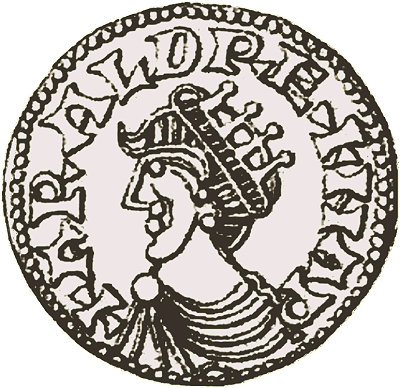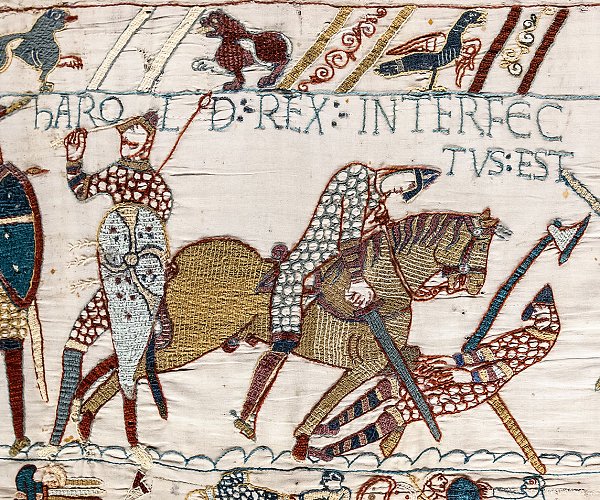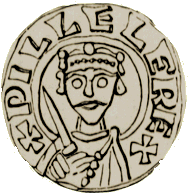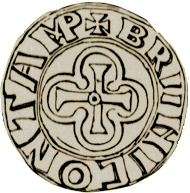| The Invasion The Normans
were descended from Vikings, who had settled in
Normandy, married into the local population and adopted
the French culture. It is believed that in 1051 King
Edward of England named his distant relative, William
Duke of Normandy as his successor. So William had claim
to the English throne.
Edward died on the 5th January, 1066 and on the
following day, Harold was crowned as the new king in
Westminster Abbey. His rivals to the throne had been William Duke of Normandy and Harald Hardrada
of Norway.
The Norman invasion had been expected and so Harold
made plans to defend the country. The
Anglo-Saxon Chronicle claimed that by June 1066 Harold
had gathered such a great naval force, and a land force
also, as no other king in the land had gathered before.
His plans however, were thrown into disarray when his
estranged brother Tostig, Earl of Northumbria and Harald
Hardrada of Norway led an invading army from the
northeast. |
|

A Harald Hardrada coin. |
At the beginning of September, 1066, Harald
Hardrada's army raided Scarborough and slaughtered most
of its inhabitants. On the 20th September, Hardrada and
Tostig won a battle at Fulford Gate and on the 24th
September they captured York.
Harold and his English army
travelled the 200 miles from London to York and fought
the invading army at Stamford Bridge, on the 25th
September. Both Hardrada and Tostig were killed during
the battle and large numbers of their troops were
drowned in the River Derwent.
Harold heard that William of Normandy had
landed at Pevensey Bay on 28th September with an
invading army, possibly whilst celebrating his victory in York. |
|
Harold and
his troops quickly returned to London, waiting there for
about a week before travelling south again. He had hoped
that some of the northern English troops would join him
there, but they didn't materialise. Harold and his army
marched south and
camped at Caldbec Hill, just over 8 miles to the
north west of Hastings, on the night of the 13th
October. Harold and his 7,000 strong army were at a
great disadvantage because they were suffering from the
exertions of their previous battle and the 240 mile long
march from the north.
Harold had taken a defensive
position at the top of Senlac Hill, now called Battle.
On the 14th October, Harold and his army were defeated.
During the battle, Harold and many of his troops were
killed. The traditional account of Harold dying from an
arrow to the eye and brain dates to the 1080s, but of
course is unproven. William was crowned in London on
Christmas day 1066. |
| The image of the wounded King
Harold on the Bayeux Tapestry. |
 |
After the invasion, the Normans quickly gained control of the
southern part of the county, but were met with hostility
in the north and east.
King William initially had control of the old kingdoms
of Essex, Kent, Wessex, Sussex and part of Mercia. Edwin
Earl of Mercia and his brother Morcar, Earl of
Northumbria, were delighted that William had overthrown
the Godwin family in Wessex. They believed that he would
be satisfied with the territory he had already gained
and so would leave them in control of their kingdoms. If
they had understood their true situation and attacked
William before he became established, they may have been
able to overthrow him.
Three months after his coronation, King William returned
to France and took with him the people who were most
likely cause trouble while he was away, including
Edwin and Morcar. During his absence, unrest began to
grow and there was an attempted invasion by Eustace,
Count of Boulogne, who was Edward the Confessor’s
brother-in-law.William hastily returned in December 1067 and set about
consolidating his hold on the country. He took Exeter
after an 18 day siege and began to build castles at
important sites. His wife Matilda arrived here in 1068
and was crowned Queen. When he returned to Normandy in
1069, one of his most formidable lieutenants, Robert de Commines, and 500 of his followers were slaughtered
after a drunken debauch in Durham.
The Norman castle at York was besieged and on the king’s
return he put down the rebellion and sacked York.
William was hated by many of the English and more
resistance to his rule was to follow.
William and his army swept through the northern counties
from Shropshire to Durham and the Scottish borders on a
mass killing spree. Villages were burned, animals
slaughtered, crops destroyed and any survivors were left
to starve. This led to the deaths of over 100,000 people
and effectively ended any further resistance in this
part of the country.
A Danish fleet arrived off the Northumbrian coast to
lend support to the general uprising. This was led by
King Swein who had as much claim to the English throne
as William, if not more. He was the nephew of King
Canute and was joined by Edgar the Atheling who was the
main English claimant to the throne. William managed to
buy-off the Danes and Edgar fled to Scotland.
|

An engraving of a silver penny from King William's
reign. |
The final English revolt took place in the fenlands of
East Anglia in 1071. Hereward the Wake led a number of
raids on the Normans from the safety of the marshes
around Ely. He was joined by Earl Morcar, whose brother
Edwin had been murdered by his own men. William sent
troops into the marshes and defeated the Saxons.
Hereward escaped but Morcar was captured and imprisoned. William felt that he could not trust the Saxons at all
and the remaining Saxon landowners had their lands
confiscated and given to trusted Normans. After 1066 most of Mercia still belonged to Earl Edwin of Mercia, but after
his death the estates were divided amongst William’s
followers. Much of local Mercia including Dudley was given to Ansculf of Picuigny who built a
motte and bailey castle at Dudley. |
Under William the medieval feudal system continued to be
used. William owned all of the land and divided it up
into areas, which were each ruled by a tenant in chief
who was one of his trusted barons. They each controlled
their area in return for payment from taxes and supplied
soldiers for the king’s army. Each area was divided into
smaller areas (manors) that were controlled by the
baron’s knights, who were called lesser or mesne tenants.
They had to take an oath of loyalty, carry out any
required duties and pay taxes for their land. Each manor
would include several villages whose inhabitants were
called peasants. There were several classes of peasant.
The highest was a freeman who was free to pursue a
trade. The other classes were owned as part of the land
and were not free to move around.
They were villiens, bordars, cottars and serfs. A
villien offered agricultural services to his lord, a
bordar was a smallholder who farmed on the edge of a
settlement, a cottar was a cottager and a serf was an
agricultural labourer. In return the lord of the manor
was supposed to protect and help them. The other major
landowner was the church and bishops and abbots could be
tenants in chief or lesser tenants.The original Dudley Castle, a
simple wooden motte and bailey, was constructed in
1070 by Ansculf de Picquigny, father of William
Fitz-Ansculf, who succeeded him. At this time the town
served as the seat of the extensive Barony of Dudley,
which possessed estates in eleven different counties
across England: Stafford, Warwick, Worcester, Surrey,
Berkshire, Northampton, Buckinghamshire, Rutland,
Oxford, Middlesex and Huntingdon.
As the country settled down under Norman rule, William
wanted to ensure that he received all of the taxes that
were owed to him. This was very complex because the
country had been divided into a large number of tax
paying manors. The solution was the Domesday Book and
work on it began in 1085 when teams of investigators
toured the country. The information gathered from all
over the country was collated into the book at
Winchester and from this precise taxes could be
calculated.
When a team of investigators arrived in an area they
would meet with the landowner, the local priest and a
group of older villagers. The information gathered was
as follows:
The name of each tenant-in-chief, tenant and
under-tenant, the total amount of land, the amount of
land under cultivation, the amount of woodland, the
number of people, animals and ploughs and any fishponds
or mills.
|
The Domesday Book was not completed until after King
William’s death on 9th September 1087. Today it is the
most important source of information about village life
in the Middle Ages.
The entry for Dudley is as follows:Dudelei, in the hundred of Clent in Worcestershire.
The town was listed as being a medium-sized manor in the
possession of Earl Edwin of Mercia prior to the Norman
Conquest, with William Fitz-Ansculf as Lord of the Manor
in 1086. It had a population of 16 households in 1086,
consisting of 3 villagers, 10 smallholders, 2 slaves and
1 smith. There was enough plough land for the lord's
plough team and 10 men's plough teams and 2 leagues of
woodland. Dudley was valued at an income of 3 pounds
annually to the lord in 1086 and 4 pounds in 1066.
|

An engraving of the reverse side of a silver penny from
William's reign. |
| There was one hide, around 120
acres, an area that a team of 8 oxen could plough in a
year and about two miles of woodland. The hide was in
the lordship’s demesne and so was part of the estate
directly held by the lord and not let out to tenants.
There was also plough land for the tenants which would
have been farmed in strips. The only free man was the
smith, who would have shod horses, made agricultural
implements, carried out simple iron work, possibly
including weapons for the castle. The total population
was probably no more than 100 people. William Fitzansculf was in control of more than 80
manors, scattered across several counties and like his
father was based at Dudley Castle. His holdings included Amblecote,
Aston, Birmingham, Bushbury, Chasepool,
Edgbaston, Enville, Erdington, Essington, Great Barr,
Handsworth, Himley, Moseley, Newport Pagnell, Orton,
Oxley, Pendeford, Perry Barr, Sedgley, Seisdon, Trysull,
Upper Penn and Lower Penn, Witton and Wombourne. |
 |
|
 |
|
 |
Return to
Beginnings |
|
Return to
the contents |
|
Proceed to the
12th to 14th century |
|